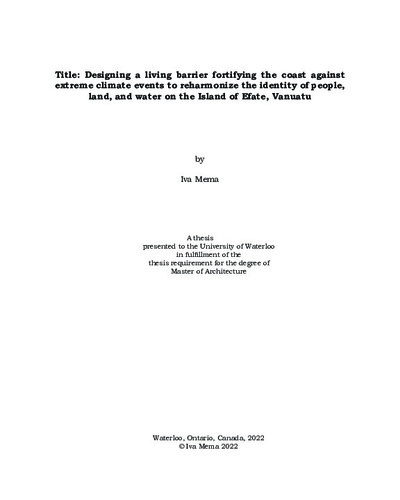| dc.description.abstract | On the Pacific island of Vanuatu, the connection the islanders have nurtured with the land and water is both evident and fundamental to their conception of life and legacy -the spirits of their ancestors are thought to inhabit the island’s minerals and express themselves through the waves. Climate change has begun to sever the sacred unity between nature and themselves. This thesis will examine the severe impacts of climate change on island systems, riparian, coastal, and marine ecosystems. In evaluating these long-reaching effects, the thesis will provide insights into the following lines of inquiry, informing the solutions and recommendations arising in consequence. An island of people is at risk of losing their homes and who they are as a nation. While exploring the island’s history, the far-reaching effects of colonial influence and their reckless disregard for the natural environment will become evident. This thesis dedicates a large section to the research on the island, identifying a limited problem and then providing a larger-scale design solution. How can implementing foreign architectural systems improve the lives and conditions of all species on the island while ensuring that design remains unintrusive, that the natural environment is utilized sustainably, and that critical lessons can be made transferrable to other contexts? In the presence of chaos, how can designs leverage disorder to create a safer environment for adaptation? Natural living systems and geotextile design have been widely explored within the field of architecture, and precedents in their usage have been discovered, whether by intention or chance. However, the interfacing between these will become a key component in designing a natural floating geotextile ecosystem that begins to counter some of the physical effects of climate change on the designated site.
Through the development of cell systems within the geotextile fabric, this thesis will begin to reintroduce a chain of ecosystems from land to ocean, supporting adaption in the hopes that the island will begin to heal itself, grasping the design intervention when grievous moments take place. Understanding the existing life systems within the island facilitates a turning point in the analysis, where the very assets threatened by climate change, the terrestrial and marine ecosystems, become the answers to addressing this threat. By analyzing these enfeebled ecosystems - their stories, art, facts, and texts -a holistic design addressing existential needs while respecting essential boundaries in the social and natural fabric can emerge into being. This story will be told through drawings and model simulations that articulate the solution to creating a resilient environment capable of seamlessly merging with the island, becoming the minerals in the soil, ceasing to exist but leaving a trace of history. The island’s dramatic edges will cease to exist, with the design working to blur the edge boundaries separating land, water, and people. By exploring native and external design concepts, this thesis aims to work with the land without disrupting local influences, utilizing natural design techniques to bring these three sources of nature together - land, people, and water. | en |

